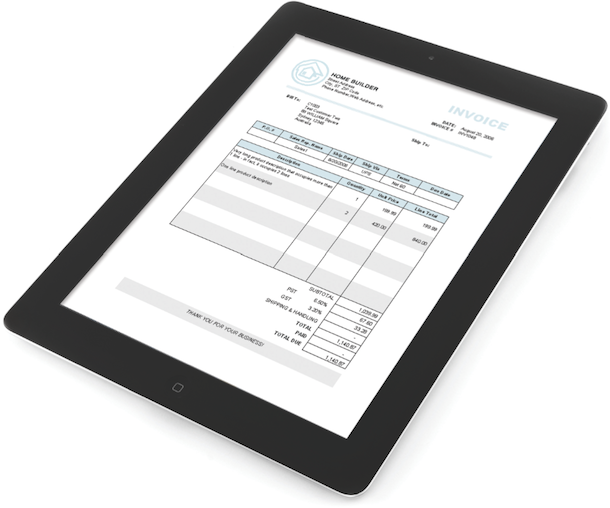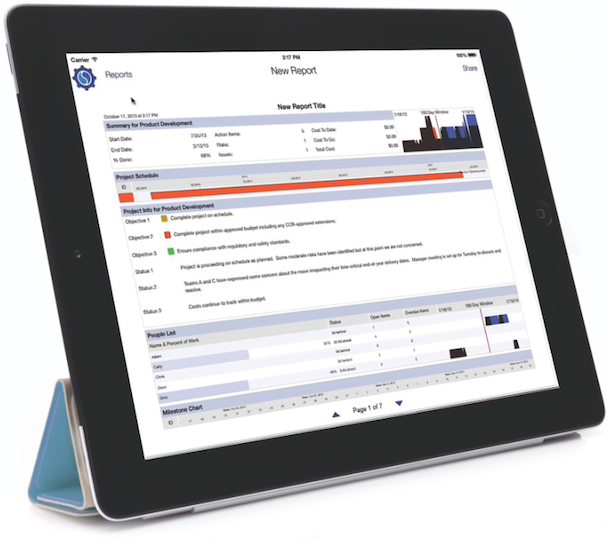Through all the coding, bits, bytes, clouds, servers, and apps, there is a fundamental purpose behind any information technology no matter if that system is used by a home builder, a bank, or a hospital. It’s all about organizing your files.
Some tasks, like scheduling, customer service, and transactional software with subcontractors might be unique to home builders, but in the big picture, the overarching goal of a big operations management system or a small mobile software application is to get the users’ arms around data and simplify business functions.
Take processing 12-month warranty inspection forms. Previously, someone at DSLD Homes, Denham Springs, La., would have to distribute the inspection notebooks to all the warranty technicians. The technicians would carry those notebooks to a customer’s home, have the homeowner complete their information, and sign off on the inspection. Then the tech would tear off that sheet and bring it back to the office, where someone would have to input that data into the computer system or at least scan it. Now, thanks to iAnnotate, a PDF document editing application, DSLD techs carry the forms on their iPads. The homeowner completes the information onscreen, and the document is emailed back to the office.
“It cuts out about seven steps, so from a process management standpoint it’s easier,” says Ryan Nash, DSLD’s product development director.
One step better, email the warranty form to the homeowner and have them fill out the report and send it back, says Joel Mezistrano, a partner with American Classic Homes. The BuildTopia integrated system used by the Mercer Island, Wash.-based builder has a warranty module that enables customers to enter and submit their requests online to the builder, which then dispatches a subcontractor or their own personnel to take care of the requested warranty work.
Mezistrano’s background as a computer science and mathematics graduate from the Massachusetts Institute of Technology is unique for the home building industry. He previously was an IT consultant with a specialty in developing workflow management software for banking and insurance clients. However, he had a passion for real estate investing and that interest eventually led him to join long-time friends Robert and Michael Gladstein at American Classic Homes. From his current perch, Mezistrano says he sees a lot of similarities between building software and building houses. One of the bigger parallels is that it’s cheaper to fix issues in the beginning of any process than near the end.

“The single most important thing that you can automate is online purchasing and scheduling,” Mezistrano says. “With purchasing not only does it make it more accurate, but there is a tremendous amount of labor saved that otherwise was spent on reconciling bills.”
Indeed, American Classic doesn’t pay from invoices submitted by its trade partners. “We just literally throw (invoices) into the garbage,” he says. Rather, the company’s payment process works this way: When customer service employees and job superintendents walk through a house with their tablets and note the dry wall, flooring, mechanical hook-ups, and whatever else has been completed, that acknowledgement tells the system the purchase orders for those tasks are finished and ready to be approved for payment. No one touches any paper. The technology eliminates payment mistakes, double paying vendors, and the possibility that vendors are changing the price without you realizing it.
Additionally, the system has freed up staff to focus on value-added rather than overhead work. Before switching to online purchasing, American Classic had a back-office employee dedicated to handling accounts payables. That role has been switched to handling transaction coordination duties.
Enterprise systems have their own portal or Web-based scheduling component, and McArthur Homes, South Jordan, Utah, has tried a few of those products. But co-owner Ron McArthur says his field staff really likes an iPad-only app from Simple Genius called SG Project Pro. “It’s not just for builders; it’s for scheduling, and it works really well. We can email a variety of reports to our trades and contractors. Our trades love it, and most of our field guys are very adept at using it.”
DIY Technology
Jagoe Homes built its own integrated operating system, a process that took about three years before launching internally in 2008 (the builder also operates Jagoe Software Solutions and Dynami Solutions to market its operations management system to builders). The Owensboro, Ky., builder’s previous information system was a collection of information silos that didn’t talk to each other. Today the company has a more efficient handle on the workflow of functions like purchasing, scheduling, and customer relationship management to the point where asset turnover improved simply by reducing the cost and time spent on overhead, says J. Scott Jagoe. (See an interview with Jagoe about his enterprise system on page 74.)
Now the builder is updating its digital storefront, or the consumer-facing side, by developing strategies for RSS feeds, blogs, social media, and search engine optimization. Jagoe’s mantra for choosing content is the more, the merrier. He explains that researching a new-home purchase is akin to what the consumer does online when comparing features and prices for a car or a flat-screen television. They’ll look up information before eventually walking into the dealership or a big-box retailer to investigate some more or even buy.
“I think when builders rushed to websites originally there was nothing else on there but your logo, a set of photographs, and something about your communities and yourself,” Jagoe says. “Early on we made a decision to put as much out there as we could. I certainly think that many people eliminate us because we have too much information out there. But we look at the website as not being much different from a model home. That’s why we have an online concierge there so we can engage them.”
He’s referring to sales associate Jennifer Lucas. Her picture appears inside a live chat box above the navigation bar on every page of jagoehomes.com and on pop-ups, inviting visitors to click if they have questions. Lucas works a flex schedule and has engaged prospects as early as 6 a.m. and as late as 11 p.m. to set up appointments to tour model homes and meet with salespeople. She also walks online visitors through a Web feature that enables homebuyers to design their dream home by clicking through screens where they can select the lot and floor plan, and choose from among hundreds of options for cabinets, counters, flooring, bath, kitchen, and much more. Of the approximately 190 closings last year, Jagoe credits 41 of those sales to having an Internet sales person.
“When we sit down and take a look at our (Web metrics), our traffic-to-sales ratio is certainly better with someone who comes in and has done their homework,” Jagoe says. “They just come in more prepared; they come in more knowledgeable. They’ve probably been on someone else’s site whether it’s Realtor.com or a competing builder, which is great. Now I can sit down with them and compare apples with apples.”
Content That Sells
Figuring out which content can not only draw traffic but also attract sales prospects is not like catching lightning in a bottle. There is a bit of science to it, says Kristi Allen, sales director for McArthur Homes. She regularly analyzes Web pages not only for the traffic that they bring, but also for traffic that leaves behind contact information that eventually leads to appointments with salespeople and model home visits.
For example, a recent how-to blog about making a built-in banquette for a bay window generated more than half of the traffic coming to mcarthurhomes.com in December and January. While the blog is very viral, it’s not the stuff that brings in sales prospects (although Allen will keep it posted because McArthur homeowners and home décor fans like it). Examples of more effective content that draws sales prospects are the “We Love Our Home” customer testimonials posted on the website and on YouTube.
Good leads also are coming from postings about community news such as the opening of a new outlet mall, a children’s museum, a wakeboard park, and doings at the local district park. Allen also gets other community news by having a feed to the McArthur blog, which posts other blogs that are tagged with the neighborhood Allen wants to feature. That information appeals to people who are interested in that community and want to know which amenities and attractions are available if they lived there.
However, the holy grail of marketing is the customer referral. Allen cultivated such referrals by sending sales agents to snap digital photos of the new homeowner’s house and email the images back to her. She then would manually resize the photos, upload them to the homeowner’s individual page on McArthur’s website, and finally email the homeowners their photos and a link they can use to share on Facebook and Pinterest so their friends and family can see their new home’s progress from the beginning of construction to move in.
“The homeowners loved that, but it was too much labor for me since I would spend several hours per week just doing this,” Allen says.
That is until she and her brother Matthew McArthur, a senior at Brigham Young University studying applied physics and computer sciences, together developed an app that automatically creates individual websites for each homeowner. McArthur Homes has been using the app in the past six months, and also tested it with other builders. The app, called My Home’s Story, is now packaged for sale to home builders. Users can simply enter their homebuyer’s information through the app on an iPhone or an iPad and create a new Web page and URL that functions like a blog, documenting the construction through finish phases with text and photos. Each update sends an email to customers with the new photos, a link to their personal Web page, and an invitation to share with social media sites. That same page also includes links to the home builder’s website.
“We’ve gotten quite a lot of traffic from that, and it’s better traffic because current homebuyers create much better leads,” Allen says.
Free and Custom Technology
Web-enable Your Business
The paperless society is here for home builders. Here are some ways to Use it to your advantage.
Websites and Online Marketing
Is your website everything that it can be? It is, without question, the most important tech tool you have. Surveys of home shoppers show that nearly all of them search online before they visit any actual homes. A great website can get prospective buyers to your home page with search engine optimization, then wow them with compelling images and descriptions of your homes and communities. It can function as a sales center by showing your homes in their best light and capturing the information you need to follow up with each and every customer. Prospects can be tracked and converted to sales online, and options and upgrades can be offered and selected. Structural changes can even be offered, using interactive programs that allow buyers to reconfigure a plan to their specifications.
After purchase, homeowner portals afford buyers the opportunity of watching their homes being built. And after move-in, community areas on the site can offer local info and the ability to interact with neighbors, as well as your company.
Sales and Customer Relations Management
These tools, whether used individually or in an integrated fashion, create automated systems that track and manage every facet of the home buying process. They help generate leads, manage leads obtained from both online and traditional methods, rate and qualify them, and help convert them to sales. And you can generate reports that let you know what’s working and what’s not.
Depending on the system you choose, you can build an interactive sales center and manage marketing campaigns, lots and plans, products and pricing, options and incentives. You’ll also be able to manage the contract process online, ensuring that all selections, options, and customizations are included.
Scheduling, Estimating, and Purchasing
Getting these tasks right can mean the difference between making money and blowing a budget. Comprehensive or individual systems allow you to manage the scheduling for an entire project, solicit, evaluate, and select bids, generate purchase orders, track agreements with suppliers, and make payments automatically.
These systems enable document sharing with everyone involved, keeping misinformation and mistakes to a minimum and enhancing schedule integration.
Warranty and Customer Service
From your customers’ point of view, this system is the most important one you can have. Starting after the contracts are signed, it can help you make sure your buyers are happy with their purchase and willing to recommend you to friends and family. A complete warranty and service system can schedule inspections and walk-throughs as well as service work from staff or vendors. Builders can track punch-list and warranty requests and issue work orders.
This type of system also provides a wide variety of valuable reporting programs: quality control, vendor analysis, aging of requests, and a detailed customer and construction history. And it monitors requests so that recurring problems or defects can be dealt with proactively.
Accounting
Whether you purchase a system or devise one of your own, keeping your accounting processes in order is a must-do. An integrated accounting system can manage and monitor AP and AR processing, supplier and trade invoicing, variances, automated payments, and payroll.
Best of all, it can generate all of the reports you need to keep your budgets on track: cash flow, tax liabilities, profit and loss statements, and customized financial analyses of all aspects of your business.
For the builder who is not ready to spend the dollars and months for an integrated operating system, there are tools available that can simplify tasks and help builders work quicker and better. FaceTime and Skype are free and commonly used apps that enable real-time video conferencing with vested parties when not everyone is able to meet at one site. Dropbox, an open source application, is used by many builders to provide access from anywhere to photos and work documents.
Google Earth is another free product. Scott Jagoe said his land acquisitions manager has taken that tool and layered over the land maps other notes and information, such as the boundaries for municipalities, school districts, and zoning.
DSLD is taking its paper copies of detailed field guides for the trades to the next level by creating a library of three- to five-minute videos that show how to do such tasks as flashing a window and weather wrapping a house, as well as detailing the construction tolerances that the home builder expects from subcontractors. The company has finished shooting 28 construction videos that will be available to trade partners through a log-in on a vendor portal on DSLD’s website.
“That’s the next generation of what we’re doing to try to help our trade partners grow and be able to hire people, train more effectively, and get them into our program,” Nash says. “It’s more like us saying, ‘Look, we know that you know how to frame houses, but this is how we want our windows put in.’”
DSLD also will create 17 videos to be used for internal training and about half a dozen videos for customers to educate them on such topics as the home-buying process and the phases of construction.
Ultimately, Nash envisions his superintendents using the videos on the jobsite. When they inspect a project and find something is not done properly, rather than just yelling at the trades, the super can take out a tablet and play a video to show how to do the job properly and visually demonstrate the end result that DSLD expects.
“Don’t just tell him you didn’t do it right. Take five minutes from your schedule and show him how to do it right,” Nash says. “It’s one of those things where we are going out of our way to do a little bit more, so that the supers can go out with a tool to help people rather than just shout at the problem.”
For builders who don’t want to produce their own, there is an app that provides mobile device access to almost 140 how-to videos about construction topics produced by building science experts from Building Knowledge Inc. That library is available on ConstuctionInstruction.com.
“It has videos, images, and templates, and is available in both English and Spanish, so the field guys can say, ‘Look, this is how you’re supposed to flash a window,’ and they can pull it up, and it will show an animation or videos for the guys in the field, says Ron McArthur of McArthur Homes. PB












